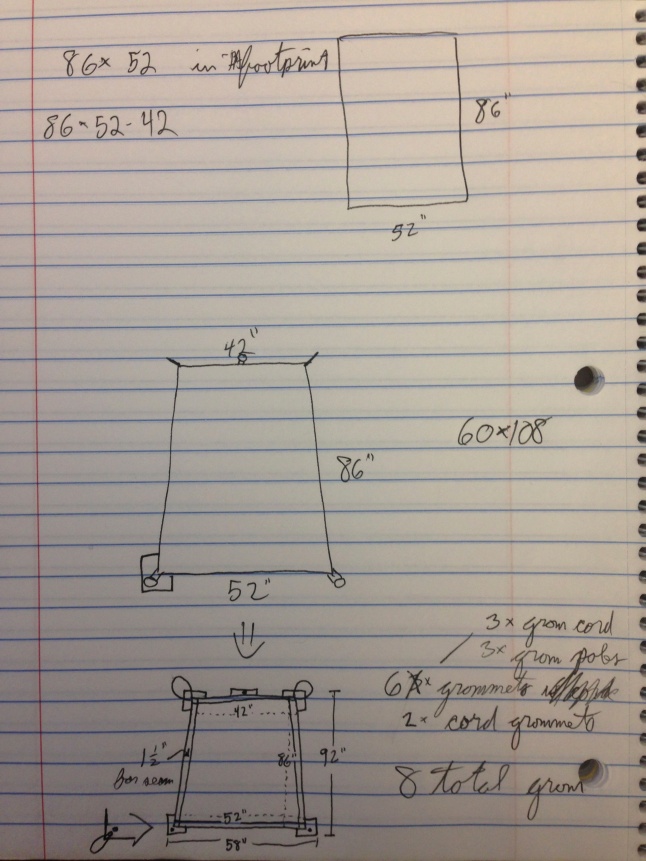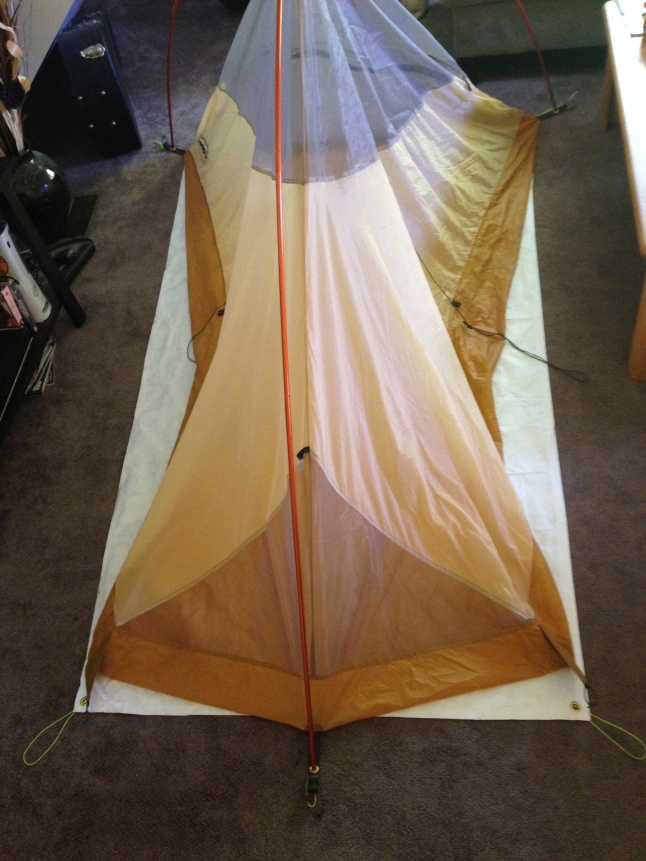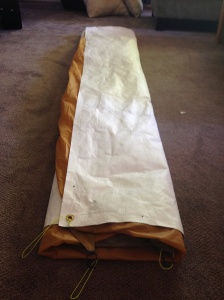As you may know, we have a Big Agnes, Fly Creek UL2 tent that we use for pretty much every backpacking trip. It’s a great tent and we love it, but because of the lightweight materials used in the tent, I fear for it’s long-term durability. (Side Note: It’s actually held up quite well and has been pitched in quite a few less-than-ideal spots with sharp branches and rocks and has performed flawlessly.) Buuuuut I would like the added reassurance of a footprint for an expensive piece of gear. In addition to protecting the tent floor from getting punctured/torn, footprints prevent water seeping in through the floor, and in the case of the Fly Creek can be used with the rainfly to pitch the tent. Unfortunately the Big Agnes footprint is quite pricy for a simple piece of cloth, and I had heard that there were good Do it Yourself (DIY) options, and so I started looking into it.
As it turns out, Tyvek is an ideal material for making footprints because it is lightweight, durable, waterproof, and inexpensive. Cuben Fiber is another great option, and is much stronger and lighter, but much more expensive. I was sold on the Tyvek and for about $20 and an hour-ish of your time, I figured I would give the DIY option a try before dropping money on a “real” footprint.
I followed this guy’s blog post the closest, and took in some considerations from many others. The pros of using this template was that it triple reenforces the corners, uses grommets to put the tent poles through, if needed, and tapes the seams. You can do it as simple as buy a piece of Tyvek and cut out the shape of your tent if you’re into that, but this footprint has virtually all the same features of a footprint bought from a big manufacturer.
Step 1: Plan it Out
First you need to know what materials you need and how much. I based my footprint on our tent, which is 86in x 52 in – 42 in, because it tapers off toward the bottom. I then added 3in to each corner in order to reenforce the corners where the grommets would be. I calculated that I needed at least 92in x 58 in of Tyvek, or would need to glue two pieces together. I would place Grommets in each of the corners and one in the center of the rear, because my tent happens to have a pole that connects at that location. Then Nylon cord would be looped around the grommets to attach to the tent stakes where the main body of the tent attaches. The seams would also be folded in 1in all the way around the perimeter to ensure that the footprint was slightly smaller than the tent, and to make the edges more durable.
Step 2: Gather Materials
Materials I used:
- 1x piece of Tyvek (Amazon: $17)
- Scraps can be found for free if you know someone who does siding on houses, or large rolls can be bought at Home Depot
- 1x grommet kit (Amazon: $10)
- Nylon Cord (had it laying around)
- Dap Contact Cement (Ace Hardware: $2)
Tools I used:
- Hammer
- Scissors
- Rolling Pin
Step 3: Measure and Draw
One you have your plan and materials, it’s time to start measuring where you are going to cut. Lay the Tyvek sheet out where you have enough area to work around it and sketch the outline of the footprint.
It helps to have another set of hands while doing this, someone to hold the ruler/tape measure and someone to draw the lines and keep the points straight. Once you have sketched your outline onto the Tyvek, it should look something like this.
Note the 3in of additional material around the corners for reenforcement.
This is how I measured and then folded the edges over to make the reenforced area. The lines with dashes through them were for measuring and were not used to cut around. The cut out corner can then be seen in the next picture.
Step 4: Cut out the Footprint
This is pretty self explanatory, cut around the outline you created, and assuming you measured correctly, the footprint should be just the right size for your tent.
Step 5: Tape the Seams
In order to make the edges of the footprint stronger, I taped the seams using the Dap Contact Cement. I used a 1 oz bottle for all of the edges, however I probably could have used more like 2-3 oz. Fold the edges over and apply the cement. I found it easiest to pre-fold the edges and then apply the cement going around the tent (without actually pressing the folded edge down). Then you’ll have glue around the perimeter of the footprint with the edges ready to be folded and glued into place. Then go around the perimeter of the footprint, in the same order you applied the glue, allowing it time to cure, and press down the edge and roll it with the rolling pin to ensure a good seal. Glue all of the edges in this manner, and the corners, and you will have quite a strong footprint.
Step 6: Apply Grommets
Now with the edges taped, apply the grommets. The grommet kit I bought had all the equipment needed to cut the hole in the footprint for the grommet, then apply the grommet. I Applied the grommets at the 4 corners and at the rear in the center for the tent pole.
Step 7: Apply Nylon Cord
This is relatively straightforward, simply tie loops of cord in order to secure the footprint to the tent stakes when pitching the tent.
All Done!
Here’s how mine turned out.
It may look a little larger than the tent in the pictures, but when the tent is staked out, the tent is about 1 in wider. Overall, I’m very happy with the finished product. It fits like a glove, and seems durable enough to last a long while. All for about $25 in materials, and I have a sizable chunk of Tyvek leftover, with many unused grommets. We plan to take this footprint with us wherever we take the tent to help protect it and hopefully prolong it’s life.
I wondered if it would fit into the same stuffsack the tent usually goes into and sure enough it fit perfectly rolled right up with the tent.
The footprint ended up coming in at just over 3 oz, keeping the weight of the tent under 3 lbs!
UPDATE 2/4/15: After the backpacking season, we’re still using the same ground cloth and it’s still in great condition! I would estimate it spend about 20-30 days out on the trail and was thoroughly abused and no attempts were made to baby it. All grommets are still in place with no signs of tearing out. It has survived wood, rock, sand, and dirt and has taken it like a champ. It’s also been used for sitting on, cooking on, and being stomped on, in addition to performing it’s duties as the tent footprint. Overall, we’re very happy with this project and hope to use Tyvek more for applications like this!
















Hey there. Quick question…now that you’ve had some time with this home-grown footprint, how has it held up? Have you needed to repair it at all?
LikeLike
Hey, thanks for asking! It has held up great all year. I would estimate it spent about 20 days on the trail, and was thoroughly abused. We use it as a ground cloth to sit on, cook on, and lounge around camp on, and have made no attempts to baby it. It’s been stomped all over directly on sand, wood, dirt, and rock and there are no tears or punctures. The “taped” or glued seams seem (see what I did there) to be coming apart a little, but honestly they don’t do much other than reenforce the grommets. The grommets are all still in great condition and are not ripping out, which I’m surprised by because when staked out with our tent it’s very tight.
Overall, it’s held up great, and better than some OEM Footprints I’ve bought in the past!
LikeLike
Hi, I have this same tent and I am always wishing that the big agnes footprint would have extended into the vestibule area of the rain fly. Do you see any reasons not to have a tyvex footprint extend to cover the vestibule and secure on the same stakes used for the vestibule?
LikeLike
Honestly I didn’t really think about it. I’m sure it would work great though. You should try it out and let me know how it goes!
LikeLike
Amazing article! I have a question!
Does this homemade footprint still allow for the fast fly option? That is a huge reason I went with the Big Agnes, Fly Creek UL2 is for the fast fly.
If you have to add clips to get this to work was it still a savings in weight? The official footprint is currently on sale for 50 so I’m torn about buying one or making one.
LikeLike
Hey, thanks for checking out the article! As I have done it, sort of. The grommets that I used allow you to put attach the poles to the footprint (though if I remember right I used 3/4″ grommets and the Fly Creek uses 1/2″ grommets – I’d double check that though). The problem is there are no clips on my footprint to attach the rainfly to the footprint. However, you can stake down the rainfly to the ground/footprint which works pretty well. You could also modify this design and simply sew in the 3 clips to mate with the rainfly (if you can find the right size – but that should be pretty doable as they come in std sizes). I can’t say for sure for weight, but my guess is this DIY footprint with the clips added would weigh less than the store bought. Or just use the stakes and you’ll be good to go!
Good luck! Let me know how it goes.
LikeLike